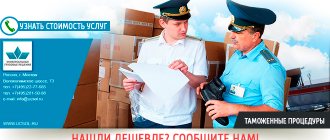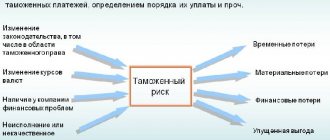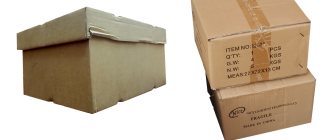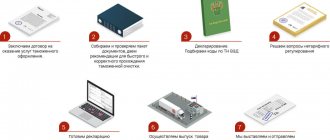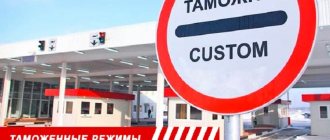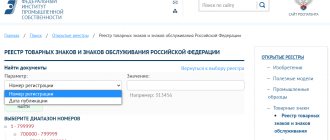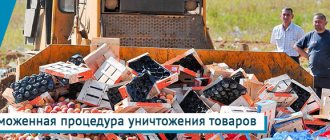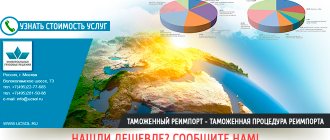Did you know that when importing for personal use goods worth less than 500 euros and weighing less than 25 kg by land or water transport, you do not need to pay a duty. If the threshold values are exceeded, a duty is charged - from 15% of the value of the goods in excess of the norm. Minimum – 2 euros per 1 kg of cargo.
Inspection and release of cargo
The purpose of customs inspection is to compare documentary and factual data about the goods, as well as to identify goods prohibited for movement. The organization of work is regulated by letter of the Federal Customs Service of Russia dated 02/06/2020 No. 01-11/06458. The inspection is carried out on the basis of an order drawn up using a specialized information system. The document indicates the purpose of the event, its scope, and a list of documents for verification and comparison. Usually this is a customs declaration and shipping documents. Up to 100% of the cargo can be inspected by weighing, opening, quantitative recalculation, with or without the use of special technical devices or dogs.
The process is recorded on camera or video. The frames should show: the location of the product, the appearance of the packaging, labeling, information about the manufacturer, release date and expiration date, degree of wear, physical dimensions and other parameters. Inspection is carried out only in the presence of the owner of the cargo or a person authorized by him (customs broker, representative).
Based on the results, a customs inspection report is drawn up, one copy of which is handed over to the cargo owner. The event should not lead to a delay in the release of goods.
This is interesting! Military equipment that moves independently, military property and personal luggage of top officials of the EAEU states are not subject to customs inspection (Article 321 of the EAEU Labor Code).
The concept of customs procedure
The customs procedure is a set of rules that determine the conditions and procedure for the use of goods within the borders of the states that are members of the Eurasian Economic Union. The rules were developed for the purpose of customs regulation of the movement of goods and vehicles and apply to each participant in foreign trade activities. Previously, instead of customs procedures, the term “customs regime” was used.
Customs procedures are regulated by the following legislative acts:
- Customs Code of the EAEU;
- Federal Law No. 289-FZ dated August 3, 2018, regulating customs clearance issues in the Russian Federation;
- Decision of the Customs Union Commission dated September 20, 2010 No. 378, which approved the classifiers of types of customs regimes;
- Other by-laws, rules, regulations.
Customs procedures are divided into four main groups:
- Basic customs procedures. These include import and export, transit transportation;
- Economic: processing of goods on the territory of the EAEU countries and beyond, for consumption on the domestic market, free and customs warehouse, temporary import, free customs territory;
- Final: re-export, re-import, refusal of goods in favor of the EAEU country, destruction;
- Temporary export: special customs regime, duty-free trade, free customs zone.
The customs procedure determines the procedure for submitting a declaration, calculating customs payments (duties, fees), deadlines for their payment, benefits, preferences, conditions for their use, and serves to control foreign trade turnover. The declarant independently, based on the goals and objectives of customs clearance, selects the appropriate mode. It must be taken into account that the customs authority has the right to make a decision that will go against the intentions of the importer or exporter.
The concept of “customs procedure” is disclosed in the Customs Code of the EAEU.
Carrying out customs control
The procedure for carrying out customs control and what is its duration?
It all depends on the chosen form of TC. Checking documents, examining or interviewing an individual rarely takes much time. As a rule, it only takes a few minutes for an experienced inspector to separate from the entire mass of incoming goods and accompanying documents those goods transported in violation of the law. The inspection can last several hours (its duration depends on the amount of cargo being inspected, the number of inspection personnel, available technical equipment, the number or complete absence of forklifts, cranes and other loading and unloading equipment). But even when the goods have been successfully released, this does not mean that control has been completed. In recent years, the Federal Customs Service of the Russian Federation has done a lot to gradually shift the emphasis of customs control from the stage preceding the release of goods to the stage following the release. This should help make the process of clearing goods through customs as easy as possible for participants in foreign trade activities, reduce its time, get rid of queues at customs and unnecessary downtime of transport. Inspectors have the right, for three years from the date of release of goods, to raise the issued declarations, verify the data stated in them, request additional documents from the declarant, or make a request to various regulatory authorities (Federal Tax Service of the Russian Federation, Ministry of Industry and Trade, Rosselkhoznadzor, Rosalkogolregulirovanie, FSB of the Russian Federation, etc.). This is a desk check (in other words, a desk check). If it reveals a discrepancy between the data stated in the DT and the actual facts (for example, a foreign trade participant sold more foreign goods than he indicated in the DT), then an on-site inspection is carried out. Sometimes specialists from the Federal Tax Service of the Russian Federation, Rosselkhoznadzor, FSTEC of the Russian Federation, the prosecutor's office and other government agencies of supervision and control are involved in it.
What applies to customs procedures
To date, 17 customs procedures are known:
- Release for domestic consumption (import). Used in relation to goods released and produced abroad that can be located and used in the territories of states; members of the Union without restrictions (free sale, exchange, etc. are allowed).
- Export. Applies to products manufactured in the EAEU countries for sale abroad.
- Customs transit. Refers to cargo that only passes along the roads, including railways, waterways, of the EAEU countries, but their final destination is outside this territory.
- Bonded warehouse. This procedure is used while imports are placed for storage in a warehouse operated by customs officials. For this period, the cargo is exempt from duties and other payments.
- Processing in customs territory. Performed in relation to imports that are subject to further processing, but in the territories of the EAEU countries in order to obtain new products from them. Subsequently, the processed product is transported outside the EAEU.
- Processing outside the customs territory. It implies the export of products manufactured within the borders of the EAEU for processing in the territories of other states and re-import into the countries of the Eurasian Union.
- Processing for domestic consumption. It involves the processing of imports for further customs clearance and sale of the final product in the EAEU countries.
- Temporary importation. The permit is issued for imports temporarily located and used in the EAEU.
- Free warehouse. Relevant for goods imported and produced in the EAEU states from a certain list, it allows you to place and use such products in a free warehouse duty-free.
- Re-export. Designed for a number of categories of imported goods that are exported from the EAEU countries, as well as those produced in the territory of the Union.
- Re-import. Indicates the import of imports that, for one reason or another, were previously exported from the countries of the Union, and are now being imported again.
- Refusal in favor of the state. Involves the transfer of imports into the ownership of the country without paying duties.
- Destruction. This operation includes imports, the import of which is prohibited or limited. No duties are paid for it.
- Free customs zone. Applies to certain goods imported and produced in the EAEU countries, which are used within the free economic zone without paying duties and other payments.
- Temporary removal. Allows duty-free export for a certain period of time of products manufactured in the countries of the Union.
- Free trade. Applies to imports and locally produced goods sold at retail in special duty-free retail outlets.
- Special customs procedure. Applies to imports and goods produced in the EAEU countries that can be cleared through customs without paying duty.
Below we will look at the main ones in more detail.
The content, application, conditions for placing products, the beginning and end of obligations to pay duties in the context of each regime are regulated by the fifth section of the EAEU Customs Code.
Features of customs control of goods
Officials can initiate a TC immediately after the goods are imported into the customs territory. When exporting, the TC can be started immediately after registration of the declaration. What is checked during TC: goods and documents; information received; time and compliance with deadlines for customs procedures; activities of persons involved in operations.
The following are subject to customs control:
- Goods transported across the customs border (including commercial consignments of goods, personal belongings of citizens, cars, international mail);
- Documents relating to goods and vehicles under customs control;
- Deadlines for completing procedures in relation to goods under customs control and operations with such goods (for example, compliance by the carrier with established deadlines for the transit of goods);
- Vehicles for the international transportation of goods (trucks, trains, ships and aircraft, various types of transport packaging (containers, wagons, etc.));
- Information relating to goods and vehicles under customs control;
- Activities of persons performing customs operations (individuals, legal entities (carriers, customs brokers, authorized economic operators, temporary storage warehouse owners, etc.)).
The procedure for placing goods under the customs procedure
Transportation of goods across state borders is carried out by both individuals and entrepreneurs; participants in foreign trade activities: in luggage, by postal delivery, by a transport company. All of them must be cleared at customs.
To place products under the customs procedure, the applicant submits to customs officers a declaration or an application for the release of products. The beginning of the process is calculated from the day the cargo is released. When importing objects of wildlife, plants and other goods subject to sanitary, quarantine and other types of control, you must first obtain a positive conclusion from the relevant supervisory authority.
There are some differences in the import and export of goods by individuals and business entities.
For a legal entity or individual entrepreneur
A foreign trade participant, his representative, a customs broker acting on behalf of a company or entrepreneur, submits a customs declaration electronically through an information system from the register of software testing certificates, for example, “Unified Automated System of Customs Terminal”, “GTD-PRO”, “Preliminary notification client”, “Electronic information submission monitor”, “Expert PI”, “Feanor”, “VED-Declarant”, etc. A complete list of programs acceptable for use is posted on the website of the Federal Customs Service.
When importing into Russia, you must pay customs duties and fees, VAT, and other payments depending on the product. Duty-free import; for cargo worth up to 200 euros.
For individuals
A citizen registers goods transported in accompanied or unaccompanied baggage at a checkpoint or at a customs post. The submission of a passenger customs declaration is carried out by him personally or through a customs broker with whom an agreement is concluded.
Cargo is exported without paying duty. What can be imported duty-free and for how long is determined by the decision of the EAEU Council dated December 20, 2017 No. 107, which discloses issues related to goods for personal use.
The obligation to place products under the customs procedure is determined by Art. 128 Labor Code of the EAEU.
The procedure for customs control
On the territory of the ZTC, customs authorities are authorized to carry out any forms of control.
Forms of customs control:
- Request and receipt of explanations from participants in foreign trade activities;
- Checking documents and information;
- Customs inspection of goods and transport;
- Customs inspection of goods and transport;
- Personal customs inspection;
- Inspection of premises and territories for customs control purposes;
- Customs check.
Receiving explanations. The inspector has the right to request additional information, receive an explanation from individuals and legal entities in order to clarify the information specified in the DT. If the interviewee has information of interest to the inspector, then he must provide it to the inspector.
Checking documents and information. The inspector needs to determine that:
- All formalities have been observed when declaring;
- All seals and stamps are present and comparable to samples;
- The documents provided on numbered forms are not stolen, not canceled and are valid (the inspector can make requests through the system of interdepartmental interaction with other departments (SMEV) to search for documents of interest in databases);
- The DT and shipping documents contain no traces of uncertified corrections, erasures, additions of text, or forgery of a seal or signature.
If necessary, the inspector has the right to reasonably request additional information from the declarant. The received documents are sent for verification (the period can range from several hours to one month).
Customs inspection (CI) and customs inspection (CD). TC consists of a visual inspection of goods, luggage, vehicles, mail and documents for them. Differences between TO and TD: during inspection, the cargo compartment of a vehicle, container, or luggage is not opened, but during inspection they are opened and the goods are removed. Therefore, TD is a more complete form of TC. Why then does customs use such an imperfect control method as inspection? The reason is that TD is a more labor-intensive and expensive form of TC. It is impractical to inspect the entire flow of goods.
The purpose of the TO is to make sure that the data declared in the DT truly describes the goods presented to customs. If there are customs seals on a container, luggage, or other transport packaging, the inspector must verify their integrity and that the cargo has not been opened (there are no signs of disassembly or dismantling).
During maintenance, inspectors often use technical means of customs control (TCC) of different classes (from simple to complex). Complex TSTCs include X-ray installations, gas analyzers, and inspection and inspection complexes (IDC). A few words about IDK. With their help, transport containers, luggage, and cargo compartments of cars are inspected. This is done in order to establish, based on the analysis of the received X-ray images, the quantity of goods in the container, its nature, and, if there are extraneous attachments, to identify them (the bulk of the goods and extraneous attachments are made of different materials, have different dimensions, different densities, and therefore X-ray images will differ from each other), identify hiding places and stashes of contraband.
The presence of the declarant at the inspection is not required. TD of goods occurs only in the presence of a foreign trade participant.
Degrees of customs inspection
- Recalculation of cargo packages with selective opening;
- Weighing (full or selective);
- Recalculation of the number of items in cargo packages selectively;
- Recalculation of cargo packages with opening of all packages;
- Measuring and determining the characteristics of goods (with partial or complete disassembly):
- No sampling or sampling;
- With taking samples and specimens;
- Recalculation of the number of items in all cargo packages.
The extent and depth of TD is determined by the head of customs. But, if necessary, the inspector can increase it. Reducing the volume and degree of TD is unacceptable.
What can cause a TD? Let's try to talk about some of them.
- First of all, these are the results of maintenance. If the inspector found damaged seals, traces of opening a sealed container, and an inspection using the IDK revealed foreign attachments in the car, then he can send a memo to the head of the post about conducting a TD of the cargo that aroused suspicion, indicating the depth of the inspection.
- Suspicions about the authenticity of the documents presented by the declarant at customs, errors made in them.
- Another factor is the triggering of a certain risk profile in the risk management system (RMS). We will talk about the work of the RMS a little later.
The result is an act drawn up by the inspector (a copy is handed over to the foreign trade participant).
Personal customs inspection is an exceptional form of control, because the inspection affects the personal rights and freedoms of the citizen. However, customs officers are forced to resort to random inspection of citizens, since there are still frequent cases when offenders tried to secretly smuggle goods across the state border on their body, in clothing, or among personal belongings. In any case, almost every one of us has seen crime news reports, which periodically talk about the detention at the border of individuals who were trying to secretly smuggle contraband.
What do you need to know about the features of personal search of citizens?
- The decision on the LTD of a particular citizen is not made by the inspector alone. A positive resolution from the head of customs is required. Only he has the right to approve and sign the LTD document. Let's consider a possible scenario. During an inspection, passport check, DT, or interview of an individual, the inspector discovers signs that the citizen is hiding some goods on him and tries to move them outside of control. The inspector draws up a report addressed to the head of customs, where he indicates the signs of the offense being committed. Based on the official document, the head of the post approves the decision to conduct LTD of an individual.
- A personal search of an individual is carried out at the ZTK. The procedure must take place in a separate special room that meets all standards (sanitary, hygienic) and is inaccessible to unauthorized persons.
- Customs notifies the citizen that it has accepted the start of inspection activities. The citizen is informed of his rights, after which he puts his signature on the form of the Decision to conduct a personal customs inspection. The citizen has the right to refuse to sign the decision, then the inspector writes down information that the person being inspected was notified of the LTD, his rights were announced to him, he was asked to independently hand over the illegally transported goods, and he refused to sign the document.
- The law clearly states: the inspector’s actions must not infringe on the honor and dignity of a citizen, cause harm to his health or damage to property.
- Attesting witnesses are brought to the LTD as witnesses. Inspection measures regarding a minor child (or an incapacitated person) require the presence of at least one of the parents (guardians). An important condition: the inspector, witnesses, and those being examined must be gender equal, that is, belong to the same sex. An examination of an individual’s body is carried out by a health worker. The operations are performed by him using special tools and medical equipment.
- The inspected citizen is obliged to comply with all lawful instructions of the inspector.
- After completion, the LTD is drawn up, signed by the inspector, the inspected citizen (his representative), witnesses and a medical worker. One copy of the document is handed over to the inspected citizen.
The inspector must remember that FTD of citizens is an interference in a person’s personal space, and therefore requires maximum compliance with ethical and moral standards. The following rules are not enshrined in law, but they should be discussed.
- If necessary, a citizen has the right to ask the inspector to allow an interpreter to see him;
- LTD is carried out by the inspector in the correct form, without humiliating the dignity of the individual, causing unlawful harm to the health and property of the person being inspected (to the extent necessary to detect goods hidden by a citizen on his or her person);
- It is prohibited to comment on the behavior of the person being searched, his possible physical disabilities, clothing, etc., etc.
- Filming, video and photography are carried out until the moment when the command is given to begin removing clothes.
A citizen has the right to make statements, petitions and include them in the act (independently or with the help of an inspector), and to appeal the actions of a customs officer.
Inspection of premises and territories for the purposes of customs control implies a visual inspection of premises and territories, as well as goods and documents. Customs authorities must ensure the presence of goods under control (including conditionally released ones), as well as the integrity of customs seals and seals on vehicles carrying goods under the transit procedure.
Inspection of premises and territories is carried out only on the basis of an order to carry out maintenance and inspection, signed by the head of the post. The form on which the order is issued must have its own serial number and contain information about the date of the inspection, the name of the object of inspection, the full name of the inspector, the number of his certificate, a note about the acquaintance of the person whose premises and territories are planned to be inspected (hereinafter referred to as the “owner/tenant”) .
Before carrying out the inspection, the inspector presents the owner/tenant with the Order and his identification. It is not recommended to obstruct the inspector, since he has the right to suppress resistance and open closed premises. Opening of locked doors must be carried out in the presence of witnesses and with notification of the prosecutor.
Duration of MOP is no more than 1 working day. day. Upon completion of the event, the inspector draws up a maintenance and inspection report, one copy of which is given to the owner (tenant).
Customs inspection is carried out:
- At temporary storage warehouses, customs warehouses, in the premises of duty-free shops to check their compliance with legal requirements, as well as to check the conditions for the presence of goods under customs control on their territories;
- At checkpoints across the state border, in customs control zones, premises located here, the territories of individuals, if there is information about goods and vehicles imported in violation of customs legislation, to verify such information;
- On the territories and premises of persons storing and disposing of goods under customs control. For example, upon receipt of information that such goods have been lost or are used and stored in violation of customs legislation, to verify such information.
Customs inspection (CI) is carried out after the goods are released. Its purpose is to make sure that the declarant (UChVED, carrier, owner of the temporary storage warehouse, AEO) complies with the legislation, in particular the conditions of the customs procedure declared during registration. Employees of various regulatory authorities (prosecutor's office, Federal Tax Service of the Russian Federation, specialists from Rosselkhoznadzor, etc.) can take part in the TC.
Inspectors compare the data reflected in accounting and statutory documents with the information stated in the DT and shipping documents.
When implementing control measures, the customs authority has the right to apply the following measures:
- Conduct an oral survey;
- Request and receive necessary documents and information;
- Identify goods, vehicles, premises, territories;
- Use technical means;
- Carry out customs escort of goods under control and vehicles for their delivery;
- Develop a route for the transportation of goods under customs control;
- Keep records of goods under customs control and customs operations performed with them;
- Invite specialists to implement customs control measures;
- Conduct customs surveillance.
General rules for all customs procedures
There are a number of provisions for carrying out customs procedures that are mandatory for all applicants and declarants (individuals and legal entities, entrepreneurs):
- Compliance with prohibitions and restrictions on the import and export of products;
- Permitting procedure for the release of goods in accordance with the declared customs procedure;
- Mandatory norms and rules approved for the selected customs regime;
- The right to choose a suitable customs procedure by the declarant and change it;
- The duty of the declarant to confirm his compliance with the conditions for placing the cargo under the customs regime;
- Responsibility of the declarant for violation of the conditions and requirements of the procedure.
General provisions for the legal regulation of customs procedures are given in Chapter 26 of the Federal Law “On Customs Regulation”.
Responsibility
Violation of the customs clearance procedure may result in liability up to criminal liability. Thus, Chapter 16 of the Code of Administrative Offenses of the Russian Federation specifies types of offenses in the field of customs affairs, for which a fine, confiscation of goods and even suspension of activities are provided:
- Art. 16.1 punishes legal entities and citizens for illegal movement across the border (outside customs, without permission, etc.) with a fine in the amount of ½ to 3 times the value of the cargo.
- Art. 16.2 for failure to declare or providing false information in the declaration, violators are also punished with a fine in the amount of ½ to double the value of the goods;
- Art. 16.3. a fine is provided for legal entities in the amount of 50 thousand - 300 thousand rubles for violating a ban or restriction on the import of certain products.
Penalties are also imposed by the counterparty for violating delivery deadlines.
Note! Even an incorrect calculation of customs duties may be regarded as evasion of customs duties and be prosecuted under Art. 194 of the Criminal Code of the Russian Federation.
The customs clearance procedure is complex, but quite passable if you have the appropriate knowledge and experience in your luggage. Entrust customs clearance to the specialists of our company. We will become your customs representative and ensure fast clearance of goods and movement across the customs border. You will fulfill your obligations to the customer and avoid fines and other sanctions. Conduct foreign trade activities competently - use the services of professionals.
How to correctly determine the customs procedure
The procedure for moving cargo across the border, the amount of customs duties and taxes, and the need/possibility of using non-tariff regulatory measures depend on the chosen customs procedure. The regime establishes requirements for the product, variations in its use, the rights and obligations of the cargo owner, and allows saving resources for participants in foreign trade activities. Therefore, the declarant must think through everything before placing the product under the customs procedure.
To determine the appropriate mode, you need to consider the following information about the product:
- Features of movement: import or export;
- Place of production (imported or manufactured directly on the territory of one of the EAEU countries);
- Terms of purchase of goods;
- Import and export period;
- Purpose of movement (sale, rent, participation in an exhibition, etc.);
- Possibility of further use of products.
Let's say an enterprise imports expensive equipment to Russia for testing in production. To save on import duties, it is recommended to use the temporary import procedure rather than import.
Similarly, to participate in a foreign exhibition, you need to arrange for the temporary export of exhibits and equipment. If export is processed after the event, you will need to pay import duties when moving samples back across the border.
Thus, the correct choice of customs procedure saves money and time.
More information about the content of customs procedures, the procedure and conditions for their use can be found in Chapter. 19 EAEU Labor Code.
Types of customs procedures
On the territory of the EAEU countries, it is customary to divide 17 types of customs procedures into four groups. Brokers of our company are professionals in their field and will select the most beneficial mode for the foreign trade participant for the import or export of cargo. Let's take a closer look at the types of customs procedures.
Basic customs procedures
When declaring goods within the framework of this procedure, duties and other customs payments must be paid, and prohibitions and restrictions for import and export are observed.
Release for domestic consumption
After customs clearance, such goods acquire the status of products of EAEU countries. They can be freely sold, exchanged, and used. In addition to import, the following goods can be placed under this customs procedure:
- Processed products exported under the re-export regime;
- Temporarily exported vehicles engaged in international transportation and placed under the processing regime outside the customs territory.
Products from the list must be imported back into the EAEU no later than three years after export. Her condition; unchanged except for normal wear and tear. A participant in foreign economic activity may submit information to the customs authority about the circumstances of the export accompanied by supporting documents. And the last condition; the product is subject to identification.
Export
Export is permitted after payment of export duties, taking into account benefits and preferences. After export, goods lose their status as EAEU cargo and are sold abroad.
Customs transit
The procedure is used for transporting goods across the territory of the EAEU countries, including crossing the borders of states that are not members of the Union. The cargo owner pays import customs, special, anti-dumping and countervailing duties and taxes. The goods must meet a number of conditions: be identifiable, transported by transport in a sealed form. Transit transportation of prohibited goods is not permitted.
Economic procedures
Economic customs procedures are characterized by the presence of economic significance and justification, connection with the international division of labor, attraction of investments, creation of new opportunities for the development of production capacities, targeted nature of the operation, that is, the use of goods for strictly defined purposes. The user of the customs procedure has the opportunity to take advantage of all economic preferences and benefits, including tax ones.
Processing in customs territory
Used for goods that will be processed or processed in the territory of the EAEU countries. Also processed products are products obtained as a result of installation, assembly, disassembly and adjustment work. Equipment that is imported for the purpose of restoration, replacement of parts, or modernization can be placed under this regime.
The procedure cannot be used for undenatured ethyl alcohol, acyclic alcohol, or biodiesel.
Processing outside the customs territory
The condition for placing goods under this customs operation is the possibility of their identification after processing. The period of temporary export for the manufacture of products by assembly, installation, restoration, etc. outside the territory of the Union countries should not be more than two years.
Processing for domestic consumption
The list of products that can be placed under this customs procedure is approved by Decree of the Government of the Russian Federation dated July 12, 2011 No. 565. It includes anode powder, pigments, glass mufflers, paints, electrolyte, membrane paper, synthetic rubber, brake pad linings, non-return valves for boilers, gearboxes, etc.
bonded warehouse
This customs procedure can be applied to goods whose shelf life is more than six months. The presence of cargo in a customs warehouse or other authorized place cannot exceed two years.
This mode cannot be used for compounds and products containing radioactive isotopes, explosives, ammunition, military equipment and equipment.
Temporary import (admission)
It is permissible to place cargo under this customs procedure if the goods can be identified and the conditions for the temporary location of the cargo, prohibitions and restrictions are met. In some cases, it is necessary to partially pay import duties. The period of temporary import is limited to two years.
You cannot use the temporary import regime to declare food products, drinks, consumables, or product samples. Exception; presentation at exhibitions, advertising shooting and other demonstration purposes.
Free warehouse
Goods placed under the free warehouse procedure are used in a limited range. They can be stored, unloaded, loaded, prepared for transportation and sale (packed, packaged, sorted, labeled), assembled, disassembled, assembled, repaired, maintained, taken samples. If these are machines and equipment, then they are used for goods processing operations.
By decision of the EAEU Council dated April 29, 2019 No. 45, it is prohibited to place imported white sugar under the procedure of a free warehouse and a free customs zone.
Final procedures
They assume the end of customs control under previously open procedures. They are not primary; they cannot be declared as an independent operation. Customs duties are not paid during final customs procedures.
Re-export
Used for customs clearance of imports already located on the territory of the state; member of the EAEU, including goods placed under the customs procedure. The re-export regime also applies to the following cargo:
- Processed products, generated waste and residues, if the operation was carried out in the EAEU country;
- Waste and residues after processing of goods for sale within the EAEU;
- New imported product, created in a free customs zone, free warehouse;
- EAEU products released for the domestic market, but not sold due to the counterparty’s failure to fulfill the terms of the transaction.
Products placed under the release procedure for domestic consumption can be cleared through customs under the re-export scheme no later than one year after submitting the release declaration.
Re-import
The scheme is used to complete customs clearance of goods for which the customs procedure of export, processing outside the customs territory, and temporary export was previously applied. Re-import is allowed within three years after the actual export of products from the territory of the EAEU. The goods must be in unaltered condition. If taxes were not paid upon export, they are subject to reimbursement.
Destruction
Produced in order to comply with the prohibitions and restrictions established by the customs code. Products are destroyed in whole or in part until they lose their consumer properties and cannot be restored.
Cultural and historical values, protected species of animals and plants, pledged, seized, seized goods, and material evidence cannot be placed under the customs destruction procedure. Also, the operation is not carried out in case of harm to the environment, people, or the need to allocate significant budgetary funds for the destruction of goods.
Refusal in favor of the state
Allowed for goods with an unexpired shelf life that complies with the technical regulations of the Customs Union. The permit is issued by the head of customs based on the application of the declarant.
The procedure for placing a person under the refusal procedure in favor of the state is regulated by Order of the Federal Customs Service of the Russian Federation dated February 21, 2011 No. 357.
Special customs procedures
Typical for some situations when it is possible to take advantage of preferential taxation.
Temporary removal
Can be applied to equipment, vehicles, and other cargo. Condition; temporarily exported goods must be brought back unchanged, with the possibility of identification. Repair, maintenance, and modernization of products are allowed.
You cannot use the customs procedure for temporary export in relation to food, drinks, including alcohol, cigarettes, consumables, samples, raw materials, semi-finished products and waste.
Special customs procedure
This customs regime is often used by diplomatic missions, scientific, sports, cultural, and military organizations under the jurisdiction of the Russian government. The procedure applies to goods to support the activities of diplomatic missions, consulates, as well as weapons, military equipment, and ammunition.
Vehicles for emergency prevention and response, humanitarian aid, medicines, sports nutrition, equipment, equipment, dietary supplements are not subject to duties.
Free trade
It is used in international departure areas at airports, seaports, as well as at other customs points. Buyers of such goods in duty-free stores can be all individuals leaving the EAEU country, arriving in it, or moving between the states of the Union.
Free customs zone
Goods for the free economic zone are subject to customs clearance under this scheme: those used by FEZ residents to conduct business.
Customs inspection after release of goods
Customs inspection after the release of goods is an effective tool for monitoring compliance by foreign trade participants with customs legislation. Customs inspection after the release of goods of the EAEU Customs Code in Article 331 is defined as a form of customs control carried out by customs authorities along with other forms. Forms of customs control are listed in Article 322 of the EAEU Labor Code, including customs inspection. Inspections can be both desk and on-site; on-site inspections, in turn, can be scheduled, unscheduled and counter. The period of customs inspection after the release of goods is limited to 3 years, but customs documents must be kept for 5 years.
On-site customs inspection, example after the release of goods: among the imported goods sold by a trade organization, the inspection revealed a product labeled as imported, but of Russian origin.
The effectiveness of customs checks after the release of goods is quite high. As a result of their implementation, violations are identified and administrative and criminal cases are initiated, as a result of which customs payments, fines and penalties are transferred to the federal budget. The results of inspections must be documented as customs inspection reports after the release of goods in a legally approved form. If the audit establishes the fact of an unreliable declaration, then a copy of this document must be sent to the declarant.
Time limits for placing goods under the customs procedure
The term for placing goods under the customs procedure means a limited period of time for which the declarant places the cargo under the selected regime, providing a product declaration for this.
This period depends on the type of customs procedure and can be extended by decision of the customs authority. For example, it can take up to four months to release goods for domestic consumption, the maximum period for customs transit is limited to 2 thousand kilometers per month, and for re-export the maximum period is two years.
The terms for placing goods under the customs procedure are determined in the EAEU Customs Code or by decisions of the commission, depending on the type of regime.
What are the deadlines for customs clearance of goods?
The timing of the release of goods is regulated by Art. 119 of the EAEU Labor Code and amount to 4 hours. The countdown begins from the moment of registration of the customs declaration. It moves if there are less than four hours left before the end of the customs office’s working day at the time of filing the declaration. The started procedure must be completed on the next business day. This is an ideal situation when the documents and cargo comply with the requirements. Otherwise, the time frame for customs clearance of goods will be many times longer. Such situations include:
- Customs officers have requested documents that confirm the accuracy of the information included in the declaration;
- The declarant applied to the Federal Customs Service with an application to amend or supplement the declaration;
- The declarant/customs representative did not make changes to the declaration at the request of customs officers.
The deadline for the release of goods when customs clearance is extended is 10 working days. Further extension is allowed only with the written permission of the head of customs. The customs authority sends a notification to the declarant or customs representative about the extension of the deadline for the release of goods no later than 1 business day following the day the permit was issued.
Judicial practice shows that it is very difficult to prove that customs officers violated the ten-day deadline for the release of goods, since the wording in the law is vague and there is no specific reason on the basis of which the extension of the period is allowed (decision of the Arbitration Court of the Primorsky Territory dated November 21, 2019 in case No. A51-7951 /2019). Therefore, the best way out is to carefully prepare for customs clearance so that no one has any questions.
Cost of customs clearance services
How much it costs to complete a customs procedure depends on the selected mode, name and characteristics of the cargo. Contact our company: we will help you choose the most advantageous customs procedure, fill out a declaration, calculate mandatory payments, and perform other actions for smooth customs control.
Reliable, competent broker; your key to successful foreign economic activity.
